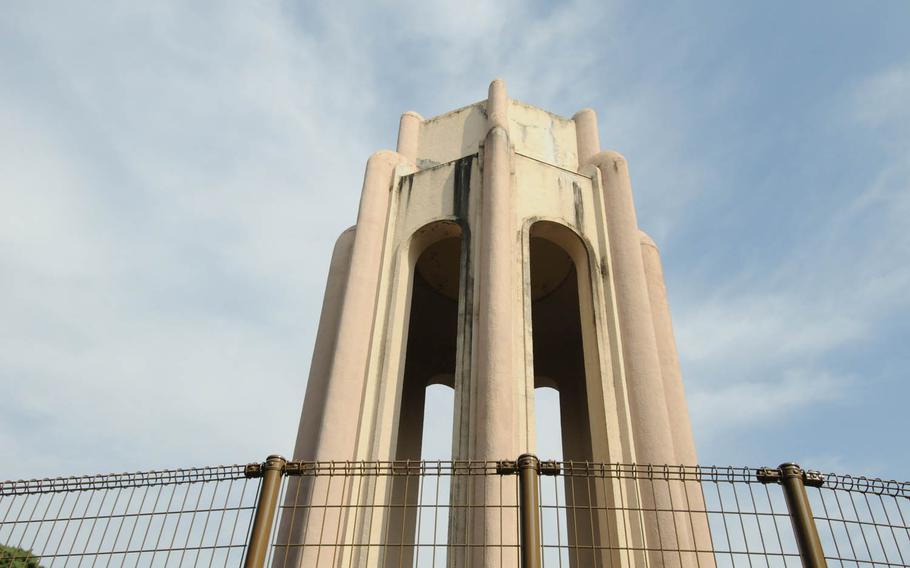
Bullet holes found on this decorative tower at Tama Reien, a cemetery in Fuchu, Tokyo, Japan, are thought to come from U.S. strafing during World War II, cemetery officials say. (Aaron Kidd/Stars and Stripes)
With nearly 38 million people crammed into the Tokyo metropolitan area, it’s ironic that one of the urban sprawl’s largest — and arguably most beautiful and intriguing — green spaces has been set aside for the dead.
That doesn’t stop the living from enjoying it, too.
Tama Reien, a 40-minute drive east of Yokota Air Base, is the largest municipal cemetery in Japan, and one of the few to imitate parklike burial grounds popular in the West. Split between the cities of Fuchu and Koganei, the 316-acre graveyard boasts wide, tree-lined streets and walkways that — aside from mourners — attract joggers, cyclists, dog-walkers, picnickers, bird-watchers and sightseers.
Founded in 1923 to address Tokyo’s great need for burial space, Tama Reien — reien means cemetery in Japanese — initially failed to catch on because of its then-rural setting, said Terunobu Yamazaki, the cemetery’s director. Tokyo’s population expanded westward as infrastructure and a train station popped up in the area, and Tama Reien’s recognition grew along with it. Its popularity skyrocketed when Adm. Heihachiro Togo, one of Japan’s greatest naval heroes, was laid to rest there in 1934.
Since then, Tama Reien has grown into a gold mine for tombstone tourists — people drawn to cemeteries by their historical relevance or famous inhabitants. Notable interments include giants of industry — the founders of Sony, Nissan Group, Bridgestone and Seiko can be found here — along with politicians, authors, artists, actors, athletes, musicians, architects, inventors and Nobel Prize winners.
One of the most popular of Tama Reien’s 424,000 inhabitants is abstract avant-garde artist Taro Okamoto, whose grave, marked by one of his whimsical sculptures, attracts many visitors, Yamazaki said. Other popular graves include author Taro Hirai, father of the Japanese detective and mystery novel, whose pen name, Edogawa Ranpo, is a Japanese rendering of American author Edgar Allan Poe.
It’s well known that the ashes of right-wing author, playwright and Nobel Prize in literature nominee Yukio Mishima are here, though cemetery officials won’t publicly acknowledge their presence. Mishima famously committed ritualistic suicide in 1970 after failing to inspire a coup among the Japan Self-Defense Forces in an attempt to restore power to the emperor.
It’s not uncommon to spot visitors, heads bowed and hands clasped, meditating before the family tomb of Shinjo Ito, founder of the Shinnyo-en school of Buddhism. A Japanese sign near the grave’s gate asks people to refrain from taking rocks decorating the plot as souvenirs.
Japan’s military history is heavily represented at Tama Reien. You can find the grave of Isoroku Yamamoto, the World War II-era admiral who planned the Dec. 7, 1941, attack on Pearl Harbor, though he opposed the war and warned that Japan could never emerge victorious over the United States. Yamamoto, a sentimental man, was known for penning personal letters to his men and to the families of those who died in the war.
“Many visitors who received letters from Yamamoto come,” Yamazaki said.
Tama Reien also hosts the remains of Korechika Anami, who served as war minister at the end of World War II. Anami committed suicide after Japan’s surrender, leaving a note that reportedly said, “I — with my death — humbly apologize to the emperor for the great crime.”
Imperial Japanese Army Air Force Kawasaki Ki-61 fighters, used to defend bombing raids from U.S. B-29 Superfortresses during World War II, from nearby Chofu Airfield were hidden in the cemetery for repairs. Though no proof exists, bullet holes found on a decorative tower that surrounds a fountain — just steps from the graves of Togo and Yamamoto — are thought to have come from U.S. strafing, Yamazaki said.
Famous remains aren’t Tama Reien’s only attraction. The cemetery’s flora and fauna are also a huge draw. Visitors will find Japanese cedar and sweet gum trees that were planted to represent the city of Fuchu, and more than 1,000 cherry trees, including weeping cherries, attract springtime strollers and picnickers.
Goshawks, eastern turtle doves, Japanese green woodpeckers, brown-eared bulbuls and swallows are often sighted by bird-watchers who frequent Tama Reien and regularly report their findings to the cemetery office.
Tama Reien’s graves are considered private property owned by the families, and Yamazaki asks that visitors not enter the plots themselves. He also advises those who enter after dark — the cemetery serves as a gathering place in case of natural disasters and must keep its gates open to pedestrians 24 hours a day — to use caution because there is no outdoor lighting.
Stars and Stripes’ staffer Hana Kusumoto contributed to this report.
Tama Reien DIRECTIONS Tama Reien, about a 40-minute drive east of Yokota Air Base, is at 4-628 Tamacho, Fuchu-shi, Tokyo. Tama Station, on the Seibu Tamagawa line, is a 10-minute walk from the cemetery’s main gate. Parking is available throughout the cemetery grounds.
TIMES Open to pedestrians 24 hours, seven days a week. Gate hours vary for automobiles, but they usually are open between 8 a.m. and 5:30 p.m.
COSTS Free
FOOD Food and drink is not available for purchase on the cemetery grounds; however, there are many restaurants and cafes between the main gate and nearby Tama Station.
INFORMATION Phone: 042-365-2079. Some staff members speak some English.